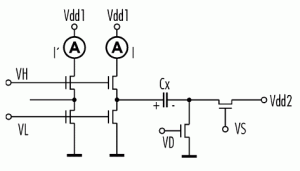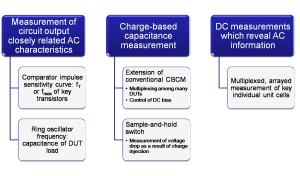AC-variability Characterization of MOSFETs
The high-frequency variability characterization of MOSFETs is becoming more necessary due to new process developments such as high-K metal gates, elevated source-drain junctions, strained silicon, and others. Some of the effects of these variability sources can be seen at low frequencies by characterizing MOSFET parameters such as threshold voltage or saturation current [1] . However, the nature of some of these sources of variability may manifest itself only at high frequencies. Therefore, one goal of this work is to design a test circuit that characterizes AC variability in MOSFETs and to quantify its relative magnitude as compared to DC variability.

Figure 2: Bias-dependent charge-based capacitance measurement for measuring capacitance vs. voltage curves for MOSFETs. [2]
The spectrum of high-frequency performance modeling ranges from small signal parameter measurement, e.g., capacitance or cutoff frequency, to large signal parameter measurement, which may include the analysis of RF distortion due to non-quasistatic effects or the evaluation of transistor delay as a lumped model (CV/I). Within this context, the range of possible AC-variability characterization platforms is shown in Figure 1. One or more of these techniques will be used to design a test chip that characterizes AC variability in deeply scaled MOSFETs. Figure 2 shows an example of a possible test circuit using a charge-based capacitance measurement technique to measure transistor gate capacitance, where the capacitance is modeled as Cx [2] [3] . For the design of this test chip, the primary goal will be to abstract away the impact of individual underlying parameters to determine the holistic device variability. Future work will focus on the isolation and examination of individual parameters of interest and will be based on the analysis of the holistic results.
References
- A. Khakifirooz, D.A. Antoniadis, “ MOSFET Performance Scaling—Part II: Future Directions,” IEEE Transactions on Electron Devices, vol. 55, no. 6, pp. 1401-1408, June 2008. [↩]
- J.C. Chen, B.W. McGaughy, D. Sylvester, and C.Hu, “An on-chip attofarad interconnect charge based capacitance measurement technique,” in Proc. International Electron Devices Meeting, 1996, pp. 69-72. [↩] [↩]
- T. Sutory and Z. Kolka, “CV characterization of nonlinear capacitors using CBCM method,” in Proc. Mixed Design of Integrated Circuits and Systems Conference, 2007, pp. 501-505. [↩]
